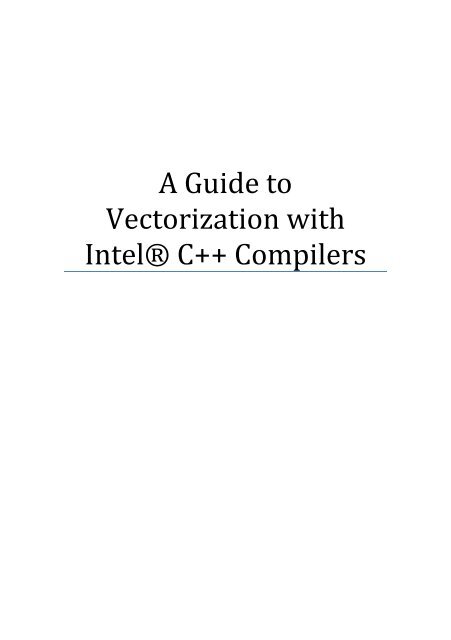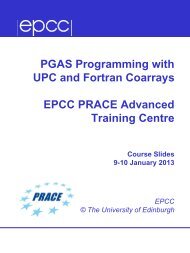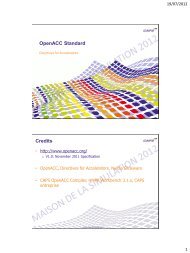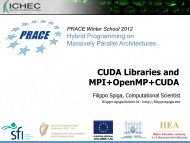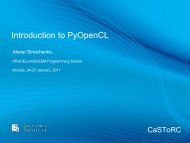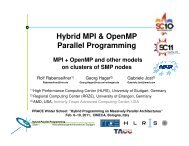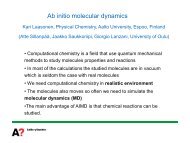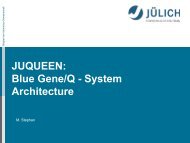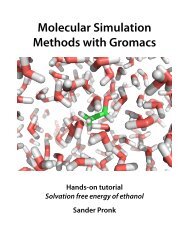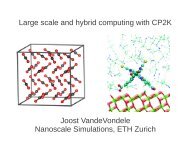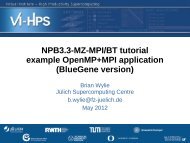A Guide to Vectorization with Intel® C++ Compilers - Prace Training ...
A Guide to Vectorization with Intel® C++ Compilers - Prace Training ...
A Guide to Vectorization with Intel® C++ Compilers - Prace Training ...
Create successful ePaper yourself
Turn your PDF publications into a flip-book with our unique Google optimized e-Paper software.
A <strong>Guide</strong> <strong>to</strong><br />
Vec<strong>to</strong>rization <strong>with</strong><br />
Intel® <strong>C++</strong> <strong>Compilers</strong>
Contents<br />
1. Introduction .............................................................................................................................................. 4<br />
2. What is Vec<strong>to</strong>rization in the Intel Compiler ............................................................................... 4<br />
2.1 When does the compiler try <strong>to</strong> vec<strong>to</strong>rize ............................................................................... 6<br />
2.2 How do I know whether a loop was vec<strong>to</strong>rized .................................................................. 6<br />
2.3 What difference does it make...................................................................................................... 7<br />
3. What sort of loops can be vec<strong>to</strong>rized ............................................................................................ 7<br />
4. Obstacles <strong>to</strong> vec<strong>to</strong>rization ................................................................................................................ 10<br />
4.1 Non-contiguous Memory Accesses ............................................................................................ 10<br />
4.2 Data Dependencies ........................................................................................................................... 11<br />
5. <strong>Guide</strong>lines for writing vec<strong>to</strong>rizable code ................................................................................... 13<br />
5.1 General <strong>Guide</strong>lines ..................................................................................................................... 13<br />
5.2 Use aligned data structures .................................................................................................... 13<br />
5.3 Prefer Structure of Arrays (SoA) over Array of Structures (AoS) .......................... 15<br />
5.4 Vec<strong>to</strong>rization <strong>Guide</strong>lines for Data Structures ................................................................. 18<br />
6. Vec<strong>to</strong>rization Reports ........................................................................................................................ 20<br />
6.1 Examples of Vec<strong>to</strong>rization Report Messages .................................................................. 20<br />
6.2 Help the compiler <strong>to</strong> vec<strong>to</strong>rize .............................................................................................. 21<br />
6.2.1 Pragmas ................................................................................................................................ 21<br />
6.2.2 restrict Keyword................................................................................................................ 23<br />
6.2.3 Switches ................................................................................................................................ 25<br />
7. Let the compiler help you <strong>to</strong> help the compiler <strong>to</strong> vec<strong>to</strong>rize ............................................. 25<br />
7.1 <strong>Guide</strong>d Au<strong>to</strong>-Parallelization ................................................................................................... 25<br />
7.1.1 Default - no vec<strong>to</strong>rization on gap.cpp ....................................................................... 26<br />
7.1.2 Get GAP advice for vec<strong>to</strong>rization ................................................................................ 26<br />
7.1.3 Making changes suggested by GAP and rebuilding <strong>to</strong> vec<strong>to</strong>rize gap.cpp .. 27<br />
2
7.2 User-mandated Vec<strong>to</strong>rization (pragma simd) ............................................................... 27<br />
7.2.1 Incorrect Code .................................................................................................................... 29<br />
7.2.2 Correct Code ....................................................................................................................... 29<br />
Elemental Functions ..................................................................................................................................... 33<br />
8. Conclusion ............................................................................................................................................... 35<br />
9. Appendix .................................................................................................................................................. 35<br />
10. References .......................................................................................................................................... 37<br />
3
1. Introduction<br />
The goal of this <strong>Guide</strong> is <strong>to</strong> provide guidelines for enabling compiler<br />
vec<strong>to</strong>rization capability in the Intel® <strong>C++</strong> <strong>Compilers</strong>. This document is<br />
aimed at C/<strong>C++</strong> programmers working on systems based on Intel®<br />
processors or compatible, non-Intel processors that support SIMD<br />
instructions such as Intel® Streaming SIMD Extensions (Intel® SSE). This<br />
includes Intel 64 and most IA-32 systems, but excludes systems based on<br />
Intel® Itanium® processors. The examples presented refer <strong>to</strong> Intel SSE, but<br />
many of the principles apply also <strong>to</strong> other SIMD instruction sets. While the<br />
examples used are specific <strong>to</strong> <strong>C++</strong> programs, much of the concepts discussed<br />
are equally applicable <strong>to</strong> Fortran programs.<br />
2. What is Vec<strong>to</strong>rization in the Intel Compiler<br />
In this context, it is the unrolling of a loop combined <strong>with</strong> the generation of packed SIMD<br />
instructions by the compiler. Because the packed instructions operate on more than one<br />
data element at a time, the loop can execute more efficiently. It is sometimes referred <strong>to</strong><br />
as au<strong>to</strong>-vec<strong>to</strong>rization, <strong>to</strong> emphasize that the compiler identifies and optimizes suitable<br />
loops on its own, <strong>with</strong>out requiring any special action by the programmer.<br />
If you are familiar <strong>with</strong> this concept, you may choose <strong>to</strong> skip the additional technical<br />
background below and move on <strong>to</strong> the next section, “When does the compiler try <strong>to</strong><br />
vec<strong>to</strong>rize”<br />
Today’s CPUs are highly parallel processors <strong>with</strong> different levels of parallelism. We find<br />
parallelism everywhere from the parallel execution units in a CPU core, up <strong>to</strong> the SIMD<br />
(Single Instruction, Multiple Data) instruction set and the parallel execution of multiple<br />
threads. The use of the Intel SSE instruction set, which is an extension <strong>to</strong> the x86<br />
architecture, is called vec<strong>to</strong>rization. In Computer science the process of converting an<br />
algorithm from a scalar implementation, which does an operation one pair of operands<br />
at a time, <strong>to</strong> a vec<strong>to</strong>r process where a single instruction can refer <strong>to</strong> a vec<strong>to</strong>r (series of<br />
adjacent values) is called vec<strong>to</strong>rization. SIMD instructions operate on multiple data<br />
elements in one instruction and make use of the 128-bit SIMD floating-point registers.<br />
4
Intel originally added eight new 128-bit registers known as XMM0 through XMM7. For<br />
the 64-bit extensions additional eight registers XMM8-XMM15 were added.<br />
Programmers can exploit vec<strong>to</strong>rization <strong>to</strong> speedup certain parts of their code. Writing<br />
vec<strong>to</strong>rized code can take additional time but is mostly worth the effort, because the<br />
performance increase may be substantial. One major research <strong>to</strong>pic in computer science<br />
is the search for methods of au<strong>to</strong>matic vec<strong>to</strong>rization: seeking methods that would allow<br />
a compiler <strong>to</strong> convert scalar algorithms in<strong>to</strong> vec<strong>to</strong>rized algorithms <strong>with</strong>out human<br />
assistance. The Intel® Compiler can au<strong>to</strong>matically generate Intel SSE instructions.<br />
This <strong>Guide</strong> will focus on using the Intel® Compiler <strong>to</strong> au<strong>to</strong>matically generate SIMD code,<br />
a feature which will be referred as au<strong>to</strong>-vec<strong>to</strong>rization henceforth. We also give some<br />
guidelines that will help the compiler <strong>to</strong> au<strong>to</strong>-vec<strong>to</strong>rize. However, in some cases, certain<br />
keywords or directives have <strong>to</strong> be applied in the code for au<strong>to</strong>-vec<strong>to</strong>rization <strong>to</strong> occur.<br />
So where does the vec<strong>to</strong>rization speedup come from Let’s look at a sample code<br />
fragment, where a, b and c are integer arrays:<br />
for(i=0;i
So we have a lot of unused space in our SIMD registers which could hold three additional<br />
integers. If vec<strong>to</strong>rization is enabled, the compiler may use the additional registers <strong>to</strong><br />
perform 4 additions in a single instruction:<br />
2.1 When does the compiler try <strong>to</strong> vec<strong>to</strong>rize<br />
The compiler will look for vec<strong>to</strong>rization opportunities whenever you compile at default<br />
optimization (-O2) or higher. These options are available for both Intel® and non-Intel<br />
microprocessors but they may result in more optimizations for Intel microprocessors<br />
than for non-Intel microprocessors. To allow comparisons of vec<strong>to</strong>rized <strong>with</strong><br />
unvec<strong>to</strong>rized code, vec<strong>to</strong>rization may be disabled <strong>with</strong> the switch /Qvec- (Windows*)<br />
or -no-vec (Linux* or Mac OS* X). The compiler will not vec<strong>to</strong>rize at –O1 or below.<br />
2.2 How do I know whether a loop was vec<strong>to</strong>rized<br />
The vec<strong>to</strong>rization report (described more fully in the Vec<strong>to</strong>rization Reports section )<br />
may be enabled <strong>with</strong> the switch /Qvec-report (Windows) or –vec-report (Linux* or Mac<br />
OS* X). This will result in a one line message for every loop that is vec<strong>to</strong>rized, of the<br />
form:<br />
> icl /Qvec-report MultArray.c<br />
MultArray.c(92): (col. 5) remark: LOOP WAS VECTORIZED.<br />
6
The source line number (92 in the above example) refers <strong>to</strong> the beginning of the loop.<br />
From the IDE, select Project \ Properties \ C/<strong>C++</strong> \ Diagnostics \ Optimization<br />
Diagnostic Level as “minimum” and Optimization Diagnostic Phase as “The High<br />
Performance Optimizer phase, /Qopt-report-phase:hpo”.<br />
By choosing instead /Qvec-report2 (-vec-report2), or “medium” instead of “minimum”<br />
in the IDE, you will also get a diagnostic message for every loop that was not vec<strong>to</strong>rized,<br />
<strong>with</strong> a brief explanation of why not.<br />
2.3 What difference does it make<br />
Vec<strong>to</strong>rization should improve loop performance in general. To illustrate this point,<br />
please open an Intel® Compiler command line window. For example, from the Start<br />
menu on Windows, select All Programs\Intel Parallel Composer\Command<br />
prompt\Intel64 Visual Studio 2008 mode. On Linux or Mac OS X, source the<br />
initialization script for your Linux compiler version in the compiler bin/intel64 or<br />
bin/ia32 direc<strong>to</strong>ries as described in the corresponding release notes.<br />
Navigate <strong>to</strong> the “example1” direc<strong>to</strong>ry. The small application multiplies a vec<strong>to</strong>r by a<br />
matrix using the following loop:<br />
for (j = 0;j < size2; j++) {<br />
b[i] += a[i][j] * x[j];<br />
}<br />
Now build and run the application by typing (on Windows):<br />
icl /O2 /Qvec- MultArray.c /FeNoVectMult<br />
NoVectMult<br />
icl /O2 /Qvec-report MultArray.c /FeVectMult<br />
VectMult<br />
On Linux or Mac OS X, type equivalently:<br />
icc -O2 -no-vec MultArray.c -o NoVectMult<br />
./NoVectMult<br />
icc -O2 -vec-report MultArray.c -o VectMult<br />
./VectMult<br />
Compare the timing of the two runs. You may see that the vec<strong>to</strong>rized version ran faster.<br />
3. What sort of loops can be vec<strong>to</strong>rized<br />
To be vec<strong>to</strong>rizable, loops must meet the following criteria:<br />
7
1. Countable<br />
The loop trip count must be known at entry <strong>to</strong> the loop at runtime, though it need<br />
not be known at compile time. (I.e., the trip count can be a variable, but the variable<br />
must remain constant for the duration of the loop). This implies that exit from the<br />
loop must not be data-dependent.<br />
2. Single entry and single exit<br />
This is implied by countable. Here is an example of a loop that is not vec<strong>to</strong>rizable<br />
due <strong>to</strong> a second data-dependent exit:<br />
void no_vec(float a[], float b[], float c[])<br />
{<br />
int i = 0.;<br />
while (i < 100) {<br />
a[i] = b[i] * c[i];<br />
// this is a data-dependent exit condition:<br />
if (a[i] < 0.0)<br />
break;<br />
++i;<br />
}<br />
}<br />
> icc -c -O2 -vec-report2 two_exits.cpp<br />
two_exits.cpp(4) (col. 9): remark: loop was not vec<strong>to</strong>rized:<br />
nonstandard loop is not a vec<strong>to</strong>rization candidate.<br />
3. Straight-line code Because SIMD instructions perform the same operation on data<br />
elements from multiple iterations of the original loop, it is not possible for different<br />
iterations <strong>to</strong> have different control flow, i.e., they must not branch. Thus switch<br />
statements are not allowed. However, “if” statements are allowed if they can be<br />
implemented as masked assignments, which is usually the case. The calculation is<br />
performed for all data elements, but the result is s<strong>to</strong>red only for those elements for<br />
which the mask evaluates <strong>to</strong> true. Thus, the following example may be vec<strong>to</strong>rized:<br />
#include <br />
void quad(int length, float *a, float *b,<br />
float *c, float *restrict x1, float *restrict x2)<br />
{<br />
for (int i=0; i= 0 ) {<br />
s = sqrt(s) ;<br />
x2[i] = (-b[i]+s)/(2.*a[i]);<br />
x1[i] = (-b[i]-s)/(2.*a[i]);<br />
}<br />
else {<br />
x2[i] = 0.;<br />
x1[i] = 0.;<br />
}<br />
}<br />
}<br />
> icc -c -restrict -vec-report2 quad.cpp<br />
quad5.cpp(5) (col. 3): remark: LOOP WAS VECTORIZED.<br />
8
4. The innermost loop of a nest The only exception is if an original outer loop is<br />
transformed in<strong>to</strong> an inner loop as a result of some other prior optimization phase,<br />
such as unrolling, loop collapsing or interchange.<br />
5. No function calls The two major exceptions are for intrinsic math functions and<br />
for functions that may be inlined. Even a print statement is sufficient <strong>to</strong> render a<br />
loop unvec<strong>to</strong>rizable. The vec<strong>to</strong>rization report message is typically “nonstandard<br />
loop is not a vec<strong>to</strong>rization candidate”.<br />
Intrinsic math functions such as sin(), log(), fmax(), etc., are allowed, since the compiler<br />
runtime library contains vec<strong>to</strong>rized versions of these functions. Table 1 lists these<br />
functions. Most exist in both float and double versions.<br />
Table 1. Functions for which the compiler has a vec<strong>to</strong>rized version.<br />
acos ceil fabs round<br />
acosh Cos floor sin<br />
asin Cosh fmax sinh<br />
asinh erf fmin sqrt<br />
atan Erfc log tan<br />
atan2 Erfinv log10 tanh<br />
atanh Exp log2 trunc<br />
cbrt exp2 pow<br />
Thus the loop in the following example may be vec<strong>to</strong>rized, since sqrtf() is vec<strong>to</strong>rizable<br />
and func() gets inlined. Inlining is enabled at default optimization for functions in the<br />
same source file. (An inlining report may be obtained by setting /Qopt-report-phase<br />
ipo_inl (-opt-report-phase ipo_inl). )<br />
float func(float x, float y, float xp, float yp) {<br />
float denom;<br />
denom = (x-xp)*(x-xp) + (y-yp)*(y-yp);<br />
denom = 1./sqrtf(denom);<br />
return denom;<br />
}<br />
float trap_int<br />
(float y, float x0, float xn, int nx, float xp, float yp) {<br />
float x, h, sumx;<br />
int i;<br />
h = (xn-x0) / nx;<br />
sumx = 0.5*( func(x0,y,xp,yp) + func(xn,y,xp,yp) );<br />
9
for (i=1;i icc -c -vec-report2 trap_integ.c<br />
trap_int.c(16) (col. 3): remark: LOOP WAS VECTORIZED.<br />
4. Obstacles <strong>to</strong> vec<strong>to</strong>rization<br />
The following do not always prevent vec<strong>to</strong>rization, but frequently either prevent it or<br />
cause the compiler <strong>to</strong> decide that vec<strong>to</strong>rization would not be worthwhile.<br />
4.1 Non-contiguous Memory Accesses<br />
Four consecutive ints or floats, or two consecutive doubles, may be loaded directly from<br />
memory in a single SSE instruction. But if the four ints are not adjacent, they must be<br />
loaded separately using multiple instructions, which is considerably less efficient. The<br />
most common examples of non-contiguous memory access are loops <strong>with</strong> non-unit<br />
stride or <strong>with</strong> indirect addressing, as in the examples below. The compiler rarely<br />
vec<strong>to</strong>rizes such loops, unless the amount of computational work is large compared <strong>to</strong><br />
the overhead from non-contiguous memory access.<br />
// arrays accessed <strong>with</strong> stride 2<br />
for (int i=0; i
4.2 Data Dependencies<br />
Vec<strong>to</strong>rization entails changes in the order of operations <strong>with</strong>in a loop, since each SIMD<br />
instruction operates on several data elements at once. Vec<strong>to</strong>rization is only possible if<br />
this change of order does not change the results of the calculation.<br />
<br />
<br />
The simplest case is when data elements that are written (s<strong>to</strong>red <strong>to</strong>) do not appear<br />
in any other iteration of the individual loop. In this case, all the iterations of the<br />
original loop are independent of each other, and can be executed in any order,<br />
<strong>with</strong>out changing the result. The loop may be safely executed using any parallel<br />
method, including vec<strong>to</strong>rization. All the examples considered so far fall in<strong>to</strong> this<br />
category.<br />
Read-after-write: When a variable is written in one iteration and read in a<br />
subsequent iteration, there is a “read-after-write” dependency, also known as a flow<br />
dependency, as in this example:<br />
A[0]=0;<br />
for (j=1; j
A[j-1]=A[j]+1;<br />
B[j]=A[j]*2;<br />
}<br />
// this is equivalent <strong>to</strong>:<br />
A[0]=A[1]+1; A[1]=A[2]+1; A[2]=A[3]+1; A[3]=A[4]+1;<br />
<br />
<br />
Read-after-read: These situations aren’t really dependencies, and do not prevent<br />
vec<strong>to</strong>rization or parallel execution. If a variable is not written, it does not matter<br />
how often it is read.<br />
Write-after-write: Otherwise known as ‘output’, dependencies, where the same<br />
variable is written <strong>to</strong> in more than one iteration, are in general unsafe for parallel<br />
execution, including vec<strong>to</strong>rization.<br />
However, there is a very important exception that apparently contains all of the above<br />
types of dependency:<br />
sum=0;<br />
for (j=1; j
5. <strong>Guide</strong>lines for writing vec<strong>to</strong>rizable code<br />
5.1 General <strong>Guide</strong>lines<br />
Here are some general guidelines for helping the compiler better vec<strong>to</strong>rizer your code.<br />
<br />
<br />
<br />
<br />
<br />
<br />
Prefer countable single entry and single exit “for” loops. Avoid complex loop<br />
termination conditions – the loop lower bound and upper bound must be invariant<br />
<strong>with</strong>in the loop. It’s OK for it <strong>to</strong> be a function of the outer loop indices, for the<br />
innermost loop in a nest of loops.<br />
Write straight line code (avoid branches such as switch, go<strong>to</strong> or return statements,<br />
most function calls, or “if” constructs that can’t be treated as masked assignments).<br />
Avoid dependencies between loop iterations, or at least, avoid read-after-write<br />
dependencies<br />
Prefer array notation <strong>to</strong> the use of pointers. C programs in particular impose very<br />
few restrictions on the use of pointers; aliased pointers may lead <strong>to</strong> unexpected<br />
dependencies. Without help, the compiler often cannot tell whether it is safe <strong>to</strong><br />
vec<strong>to</strong>rize code containing pointers.<br />
Use the loop index directly in array subscripts where possible, instead of<br />
incrementing a separate counter for use as an array address.<br />
Use efficient memory accesses<br />
o<br />
o<br />
o<br />
o<br />
Favor inner loops <strong>with</strong> unit stride<br />
Minimize indirect addressing<br />
Align your data <strong>to</strong> 16 byte boundaries (for Intel® SSE instructions)<br />
Align your data <strong>to</strong> 32 byte boundaries (for Intel® Advanced Vec<strong>to</strong>r<br />
Extensions (Intel® AVX))<br />
Choose carefully a suitable data layout. Most multimedia extension instruction sets are<br />
rather sensitive <strong>to</strong> alignment. The data movement instructions of SSE/SSEx, for<br />
example, operate much more efficiently on data that is aligned at a 16-byte boundary in<br />
memory. Therefore, the success of a vec<strong>to</strong>rizing compiler also depends on its ability <strong>to</strong><br />
select an appropriate data layout that, in combination <strong>with</strong> code restructuring (like loop<br />
peeling), will result in aligned memory accesses throughout the program. If your<br />
compilation targets the Intel® AVX instruction set, you should try <strong>to</strong> align data on a 32-<br />
byte boundary. This may result in improved performance.<br />
5.2 Use aligned data structures<br />
Data structure alignment is the adjustment of any data object in relation <strong>with</strong> other<br />
objects. The Intel® <strong>Compilers</strong> may align individual variables <strong>to</strong> start at certain<br />
addresses <strong>to</strong> speed up memory access. Misaligned memory accesses can incur large<br />
performance losses on certain target processors that do not support them in hardware.<br />
Alignment is a property of a memory address, expressed as the numeric address modulo<br />
13
a power of 2. In addition <strong>to</strong> its address, a single datum also has a size. A datum is called<br />
naturally aligned if its address is aligned <strong>to</strong> its size and misaligned otherwise. For<br />
example, an 8-byte floating-point datum is naturally aligned if the address used <strong>to</strong><br />
identify it is aligned <strong>to</strong> 8. A data structure is a way of s<strong>to</strong>ring data in a computer so that<br />
it can be used efficiently. Often a carefully chosen data structure will allow a more<br />
efficient algorithm <strong>to</strong> be used. A well-designed data structure allows a variety of critical<br />
operations <strong>to</strong> be performed, using as little resources, both execution time and memory<br />
space, as possible.<br />
struct MyData{<br />
short<br />
short<br />
short<br />
Data1;<br />
Data2;<br />
Data3;};<br />
If the type short is s<strong>to</strong>red in two bytes of memory then each member of the data<br />
structure depicted above would be aligned <strong>to</strong> a boundary of 2 bytes. Data1 would be at<br />
offset 0, Data2 at offset 2 and Data3 at offset 4. The size of this structure then would be<br />
6 bytes. The type of each member of the structure usually has a required alignment,<br />
meaning that it will, unless otherwise requested by the programmer, be aligned on a<br />
pre-determined boundary. In cases where the compiler has taken sub-optimal<br />
alignment decisions, however, the programmer can use the directive<br />
declspec(align(base,offset)), where 0
If pointer variables are used, the compiler is usually not able <strong>to</strong> determine the alignment<br />
of access patterns at compile time. Consider the following simple fill function:<br />
void fill(char *x) {<br />
}<br />
int i;<br />
for (i = 0; i < 1024; i++){<br />
}<br />
x[i] = 1;<br />
Without more information, the compiler cannot make any assumption on the alignment<br />
of the memory region accessed by this loop. At this point, the compiler may decide <strong>to</strong><br />
vec<strong>to</strong>rize this loop using unaligned data movement instructions or, as done by the Intel<br />
C/<strong>C++</strong> compiler, generate the run-time alignment optimization shown here:<br />
peel = x & 0x0f;<br />
if (peel != 0) {<br />
}<br />
peel = 16 - peel;<br />
/* runtime peeling loop */<br />
for (i = 0; i < peel; i++){<br />
x[i] = 1;<br />
}<br />
/* aligned access */<br />
for (i = peel; i < 1024; i++){<br />
x[i] = 1;<br />
}<br />
Run-time optimization provides a generally effective way <strong>to</strong> obtain aligned access<br />
patterns at the expense of a slight increase in code size and testing. If incoming access<br />
patterns are guaranteed <strong>to</strong> be aligned at a 16-byte boundary, however, the programmer<br />
can avoid this overhead <strong>with</strong> the hint __assume_aligned(x, 16); in the function <strong>to</strong><br />
convey this information <strong>to</strong> the compiler. Note that this hint must also be used <strong>with</strong> care<br />
because incorrect usage of aligned data movements will result in an exception for SSE.<br />
5.3 Prefer Structure of Arrays (SoA) over Array of Structures (AoS)<br />
The most common and likely well-known data structure is the array, which contains a<br />
contiguous collection of data items that can be accessed by an ordinal index. This data<br />
can be organized as an Array Of Structures (AOS) or a Structure Of Arrays (SOA). While<br />
AOS organization is excellent for encapsulation it can be poor for use of vec<strong>to</strong>r<br />
15
processing. Selecting appropriate data structures can also make vec<strong>to</strong>rization of the<br />
resulting code more effective. To illustrate this point, compare the traditional array-ofstructures<br />
(AoS) arrangement for s<strong>to</strong>ring the r, g, b components of a set of threedimensional<br />
points <strong>with</strong> the alternative structure-of-arrays (SoA) arrangement for<br />
s<strong>to</strong>ring this set.<br />
Point Structure :<br />
R G B<br />
struct Point{ //AoS<br />
float r;<br />
float r;<br />
float g;<br />
}<br />
Structure of Arrays:<br />
R G B R G B R G B<br />
struct Points{ //SoA<br />
float* x;<br />
float* y;<br />
float* z;<br />
}<br />
R R R G G G B B B<br />
With the AoS arrangement, a loop that visits all components of an RGB point before<br />
moving <strong>to</strong> the next point exhibits a good locality of reference because all elements in<br />
fetched cache lines are utilized. The disadvantage of the AoS arrangement is that each<br />
individual memory reference in such a loop exhibits a non-unit stride, which, in general,<br />
adversely affects vec<strong>to</strong>r performance. Furthermore, a loop that visits only one<br />
component of all points exhibits less satisfac<strong>to</strong>ry locality of reference because many of<br />
the elements in the fetched cache lines remain unused. In contrast, <strong>with</strong> the SoA<br />
arrangement the unit-stride memory references are more amenable <strong>to</strong> effective<br />
vec<strong>to</strong>rization and still exhibit good locality of reference <strong>with</strong>in each of the three data<br />
streams. Consequently, an application that uses the SoA arrangement may ultimately<br />
outperform an application based on the AoS arrangement when compiled <strong>with</strong> a<br />
vec<strong>to</strong>rizing compiler, even if this performance difference is not directly apparent during<br />
the early implementation phase.<br />
So before you start vec<strong>to</strong>rization try <strong>to</strong> follow some simple rules:<br />
• Make your data structures vec<strong>to</strong>r-friendly<br />
16
• Make sure that inner loop indices correspond <strong>to</strong> the outermost (last) array<br />
index in your data (row-major order).<br />
• Prefer structure of arrays over array of structures<br />
For instance when dealing <strong>with</strong> 3 dimensional coordinates, use 3 separate arrays for<br />
each component (SOA), instead of using one array of 3-component structures (AOS). To<br />
avoid dependencies between loops that will eventually prevent vec<strong>to</strong>rization, it is<br />
therefore recommended <strong>to</strong> rather use 3 separate arrays for each component (SOA),<br />
instead of one array of 3-component structures (AOS), when processing 3 dimensional<br />
coordinates. In AOS, each iteration produces one result by computing XYZ_, but can at<br />
best use only 75% of the SSE unit, because the fourth component is not used.<br />
Sometimes, it may use only one component (25%). In SOA, each iteration produces 4<br />
results by computing XXXX, YYYY and ZZZZ and using 100% of the SSE unit. A drawback<br />
for SOA is that your code will likely be 3 times as long. On the other hand, the compiler<br />
might not be able <strong>to</strong> vec<strong>to</strong>rize AOS code at all.<br />
If your original data layout is in AOS format, you may even want <strong>to</strong> consider a<br />
conversion <strong>to</strong> SOA on the fly, before the critical loop. If it gets vec<strong>to</strong>rized, it may be<br />
worth the effort!<br />
AoS Example:<br />
icl /c AoSvsSoA.cpp /DAOS /Qvec-report2<br />
AoSvsSoA.cpp<br />
AoSvsSoA.cpp(18): (col. 3) remark: loop was not vec<strong>to</strong>rized:<br />
existence of vec<strong>to</strong>r dependence.<br />
17
SoA Example:<br />
icl /c AoSvsSoA.cpp /DSOA /Qvec-report2<br />
AoSvsSoA.cpp<br />
AoSvsSoA.cpp(58): (col. 3) remark: LOOP WAS VECTORIZED.<br />
<br />
<br />
5.4 Vec<strong>to</strong>rization <strong>Guide</strong>lines for Data Structures<br />
Use the smallest data types that give the needed precision, <strong>to</strong> maximize potential<br />
SIMD width. (If only 16-bits are needed, using a short rather than an int can make<br />
the difference between eight-way or four-way SIMD parallelism, respectively.)<br />
Avoid mixing vec<strong>to</strong>rizable data types in the same loop (except for integer arithmetic<br />
on array subscripts). Vec<strong>to</strong>rization of type conversions may be either unsupported<br />
or inefficient. The latest compilers, including the version 12 of the Intel® <strong>C++</strong><br />
<strong>Compilers</strong> for Windows* and Linux*, have greatly improved and can au<strong>to</strong>-vec<strong>to</strong>rize<br />
mixed type loops. But avoid if possible. The example below illustrates the mixing of<br />
data types, which may prevent au<strong>to</strong>-vec<strong>to</strong>rization.<br />
18
void mixed(float *restrict a, double *restrict b, float *c)<br />
{<br />
for(int i = 1; i < 1000; ++i)<br />
{<br />
b[i] = b[i] - c[i];<br />
a[i] = a[i] + b[i];<br />
}<br />
}<br />
<br />
<br />
Avoid operations not supported in SIMD hardware. Arithmetic <strong>with</strong> (80 bit) long<br />
doubles on Linux, and the remainder opera<strong>to</strong>r “%” are examples of operations not<br />
supported in SIMD hardware.<br />
Use all the instruction sets available for your processor. Use the appropriate<br />
command line option for your processor type, or select the appropriate IDE option<br />
under “Project / Properties / C/<strong>C++</strong> / Code Generation / Intel Processor-Specific<br />
Optimization” (/QxSSE4.1, /QxSSE4.2, etc., on Windows*) and (-xSSE4.1, -xSSE4.2,<br />
etc, on Linux* or Mac OS* X), if your application will run only on Intel processors, or<br />
“Project / Properties / C/<strong>C++</strong> / Code Generation / Enable Enhanced Instruction Set”<br />
(/arch:SSE2, /arch:SSE3 on Windows) and (-msse2, -msse3 on Linux or Mac OS X), if<br />
your application may run on compatible, non-Intel processors.<br />
If your application will run only on the processor type on which it was built, you<br />
may simply choose the command line option /QxHost (Windows) or –xhost (Linux<br />
or Mac OS X), or in the IDE, select “Project / Properties / C/<strong>C++</strong> / Code Generation /<br />
Intel Processor-Specific Optimization / The processor performing the compilation<br />
(/QxHost)”. This option is available for both Intel® and non-Intel microprocessors<br />
but it may perform more optimizations for Intel microprocessors than it performs<br />
for non-Intel microprocessors.<br />
For more details about the available processor-specific options, see the article at<br />
http://software.intel.com/en-us/articles/performance-<strong>to</strong>ols-for-softwaredevelopers-intel-compiler-options-for-sse-generation-and-processor-specificoptimizations/<br />
19
Vec<strong>to</strong>rizing compilers usually have some built-in efficiency heuristics <strong>to</strong> decide<br />
whether vec<strong>to</strong>rization is likely <strong>to</strong> improve performance. The Intel® C/<strong>C++</strong> Compiler<br />
will disable vec<strong>to</strong>rization of loops <strong>with</strong> many unaligned or non-unit stride data<br />
access patterns. However, if experimentation reveals that vec<strong>to</strong>rization will still<br />
improve performance, the programmer can override this behaviour <strong>with</strong> a<br />
“#pragma vec<strong>to</strong>r always” hint before the loop, which asks the compiler <strong>to</strong> vec<strong>to</strong>rize<br />
any loop regardless of the outcome of the efficiency analysis (provided, of course,<br />
that vec<strong>to</strong>rization is safe).<br />
6. Vec<strong>to</strong>rization Reports<br />
The Intel® Compiler provides a vec<strong>to</strong>rization report option that provides two important<br />
kinds of information. First, the vec<strong>to</strong>rization report will inform you which loops in your<br />
code are being vec<strong>to</strong>rized. The end result of a vec<strong>to</strong>rized loop is an instruction stream<br />
for that loop that contains packed SIMD instructions. Secondly and at least as important,<br />
is report information about why the compiler did NOT vec<strong>to</strong>rize a loop. This<br />
information assists a programmer by highlighting the barriers that the compiler finds <strong>to</strong><br />
vec<strong>to</strong>rization. With the Intel® compiler, one must enable the vec<strong>to</strong>rization reporting<br />
mechanism, since it is not enabled by default. In the Microsoft* Visual Studio* IDE<br />
(Integrated Development Environment), this is done by selecting from the Project menu<br />
“Properties \ C/<strong>C++</strong> \ Diagnostics \ Optimization Diagnostic Phase” as “The High<br />
Performance Optimizer phase, /Qopt-report-phase:hpo” and “Optimization Diagnostic<br />
Level” as “medium”. This corresponds <strong>to</strong> n=2 below.<br />
The -vec-report (Linux* or Mac OS X) or /Qvec-report (Windows*) options direct the<br />
compiler <strong>to</strong> generate the vec<strong>to</strong>rization reports <strong>with</strong> different levels of information. The<br />
vec<strong>to</strong>rization report option, -vec-report=, uses the argument <strong>to</strong> specify the<br />
information presented; from no information at -vec-report=0 <strong>to</strong> very verbose<br />
information at -vec-report 3. The arguments <strong>to</strong> -vec-report are:<br />
n=0: No diagnostic information<br />
n=1: Loops successfully vec<strong>to</strong>rized<br />
n=2: Loops not vec<strong>to</strong>rized - and the reason why not<br />
n=3: Adds dependency Information<br />
n=4: Reports only non-vec<strong>to</strong>rized loops<br />
n=5: Reports only non-vec<strong>to</strong>rized loops and adds dependency info<br />
6.1 Examples of Vec<strong>to</strong>rization Report Messages<br />
“Low trip count”: The loop does not have sufficient iterations for vec<strong>to</strong>rization <strong>to</strong> be<br />
worthwhile<br />
“Not Inner Loop”: Only the inner loop of a loop nest may be vec<strong>to</strong>rized.<br />
20
“Existence of vec<strong>to</strong>r dependence”: The compiler did not vec<strong>to</strong>rize the loop because<br />
of a proven or potential dependence. If you are sure that any potential dependencies are<br />
not in fact realized, you may invite the compiler <strong>to</strong> ignore them <strong>with</strong> #pragma ivdep.<br />
"vec<strong>to</strong>rization possible but seems inefficient": The compiler thinks that<br />
vec<strong>to</strong>rization may not improve the performance of this loop. You may use #pragma<br />
vec<strong>to</strong>r always <strong>to</strong> override the compiler’s performance assessment, and ask the<br />
compiler <strong>to</strong> vec<strong>to</strong>rize anyway if it is safe <strong>to</strong> do so.<br />
“Condition may protect exception”: When the compiler tries <strong>to</strong> vec<strong>to</strong>rize a loop<br />
containing an IF statement, it typically evaluates the RHS expressions for all values of<br />
the loop index, but only makes the final assignment in those cases where the conditional<br />
evaluates <strong>to</strong> TRUE. In some cases, the compiler may not vec<strong>to</strong>rize out of concern that<br />
the condition may be protecting against accessing an illegal memory address.<br />
An IVDEP pragma may be used <strong>to</strong> reassure the compiler that the conditional is not<br />
protecting against a memory exception in such cases.<br />
“data type unsupported on given target architecture”: For example, this message<br />
might occur when compiling a loop containing complex arithmetic for a target processor<br />
that supported only the SSE2 instruction set. SSE3 instructions are needed for effective<br />
vec<strong>to</strong>rization of arithmetic involving complex data types.<br />
“Statement cannot be vec<strong>to</strong>rized”: Certain statements, such as switch statements,<br />
can’t be vec<strong>to</strong>rized.<br />
“Subscript <strong>to</strong>o complex”: An array subscript may be <strong>to</strong>o complicated for the compiler<br />
<strong>to</strong> decipher the memory access pattern. Try <strong>to</strong> write subscripts as an explicit function of<br />
the main loop counter.<br />
“Unsupported Loop Structure”, “Top test could not be found”: Loops that don’t<br />
fulfill the requirements of countability, single entry and exit, etc., may generate these<br />
messages.<br />
“Opera<strong>to</strong>r unsuited for vec<strong>to</strong>rization”: Certain opera<strong>to</strong>rs, such as the “%” (modulus)<br />
opera<strong>to</strong>r, can’t be vec<strong>to</strong>rized.<br />
6.2 Help the compiler <strong>to</strong> vec<strong>to</strong>rize<br />
Here are several ways in the compiler can be provided <strong>with</strong> additional information that<br />
enable it <strong>to</strong> better vec<strong>to</strong>rize the loop.<br />
6.2.1 Pragmas<br />
Please see the compiler user and reference guide for more information, but here are a<br />
few of the key ones.<br />
21
#pragma ivdep may be used <strong>to</strong> tell the compiler that it may safely ignore any<br />
potential data dependencies. (The compiler will not ignore proven<br />
dependencies). Use of this pragma when there are in fact dependencies may<br />
lead <strong>to</strong> incorrect results.<br />
There are cases, where the compiler can’t tell by a static analysis that it is safe <strong>to</strong><br />
vec<strong>to</strong>rize, but you as a developer would know. Consider the following loop:<br />
void copy(char *cp_a, char *cp_b, int n) {<br />
}<br />
for (int i = 0; i < n; i++) {<br />
}<br />
cp_a[i] = cp_b[i];<br />
Without more information, a vec<strong>to</strong>rizing compiler must conservatively assume<br />
that the memory regions accessed by the pointer variables cp_a and cp_b may<br />
(partially) overlap, which gives rise <strong>to</strong> potential data dependencies that prohibit<br />
straightforward conversion of this loop in<strong>to</strong> SIMD instructions. At this point, the<br />
compiler may decide <strong>to</strong> keep the loop serial or, as done by the Intel C/<strong>C++</strong><br />
compiler, generate a run-time test for overlap, where the loop in the true-branch<br />
can be converted in<strong>to</strong> SIMD instructions:<br />
if (cp_a + n < cp_b || cp_b + n < cp_a)<br />
else<br />
/* vec<strong>to</strong>r loop */<br />
for (int i = 0; i < n; i++) cp_a[i] = cp_b [i];<br />
/* serial loop */<br />
for (int i = 0; i < n; i++) cp_a[i] = cp_b[i];<br />
Run-time data-dependence testing provides a generally effective way <strong>to</strong> exploit<br />
implicit parallelism in C or <strong>C++</strong> code at the expense of a slight increase in code<br />
size and testing overhead. If the function copy is only used in specific ways,<br />
however, the programmer can assist the vec<strong>to</strong>rizing compiler as follows. First, if<br />
the function is mainly used for small values of n or for overlapping memory<br />
regions, the programmer can simply prevent vec<strong>to</strong>rization and, hence, the<br />
corresponding run-time overhead by inserting a #pragma novec<strong>to</strong>r hint before<br />
the loop. Conversely, if the loop is guaranteed <strong>to</strong> operate on non-overlapping<br />
memory regions, this information can be propagated <strong>to</strong> the compiler by means<br />
of a #pragma ivdep hint before the loop, which informs the compiler that<br />
conservatively assumed data dependencies that prevent vec<strong>to</strong>rization can be<br />
ignored. This will result in vec<strong>to</strong>rization of the loop <strong>with</strong>out run-time datadependence<br />
testing.<br />
22
#pragma ivdep<br />
void copy(char *cp_a, char *cp_b, int n) {<br />
}<br />
for (int i = 0; i < n; i++) {<br />
}<br />
cp_a[i] = cp_b[i];<br />
Or use the restrict keyword, see the keyword section below.<br />
<br />
<br />
<br />
<br />
<br />
#pragma loop count (n) may be used <strong>to</strong> advise the compiler of the typical trip<br />
count of the loop. This may help the compiler <strong>to</strong> decide whether vec<strong>to</strong>rization is<br />
worthwhile, or whether or not it should generate alternative code paths for the loop.<br />
#pragma vec<strong>to</strong>r always asks the compiler <strong>to</strong> vec<strong>to</strong>rize the loop if it is safe <strong>to</strong> do<br />
so, whether or not the compiler thinks that will improve performance.<br />
#pragma vec<strong>to</strong>r align asserts that data <strong>with</strong>in the following loop is aligned (<strong>to</strong> a<br />
16 byte boundary, for SSE instruction sets).<br />
#pragma novec<strong>to</strong>r asks the compiler not <strong>to</strong> vec<strong>to</strong>rize a particular loop<br />
#pragma vec<strong>to</strong>r nontemporal gives a hint <strong>to</strong> the compiler that data will not be<br />
reused, and therefore <strong>to</strong> use streaming s<strong>to</strong>res that bypass cache.<br />
6.2.2 restrict Keyword<br />
The restrict keyword may be used <strong>to</strong> assert that the memory referenced by a pointer is<br />
not aliased, i.e. that it is not accessed in any other way. The keyword requires the use of<br />
either the /Qrestrict (-restrict) for either .c or .cpp files, or /Qstd=c99 compiler option<br />
for .c files.<br />
The example under #pragma ivdep above can also be handled using the restrict<br />
keyword.<br />
The programmer may use the restrict keyword in the declarations of cp_a and cp_b, as<br />
shown below, <strong>to</strong> inform the compiler that each pointer variable provides exclusive<br />
access <strong>to</strong> a certain memory region. The restrict qualifier in the argument list will let the<br />
compiler know that there are no other aliases <strong>to</strong> the memory <strong>to</strong> which the pointers<br />
point. In other words, the pointer for which it is used provides the only means of<br />
accessing the memory in question in the scope in which the pointers live. If the loop<br />
vec<strong>to</strong>rizes <strong>with</strong>out using the restrict keyword, the compiler will be checking for aliasing<br />
at runtime. The compiler will not do any runtime checks for aliasing if you use the<br />
restrict keyword. Using such a language extension requires an extra compiler switch,<br />
such as -Qrestrict for the Intel C/<strong>C++</strong> compiler.<br />
23
void copy(char * restrict cp_a, char * restrict cp_b, int n) {<br />
}<br />
for (int i = 0; i < n; i++) cp_a[i] = cp_b[i];<br />
Another example is the following loop which may also not get vec<strong>to</strong>rized, because of a<br />
potential aliasing problem between pointers a, b and c:<br />
// potential unsupported loop structure<br />
void add(float *a, float *b, float *c) {<br />
for (int i=0; i
6.2.3 Switches<br />
Interprocedural optimization may be enabled by /Qipo (-ipo) across source files.<br />
This may give the compiler additional information about a loop, such as trip counts,<br />
alignment or data dependencies. It may also allow inlining of function calls. In the<br />
example under “Which loops can be vec<strong>to</strong>rized”, “no function calls”, if the functions<br />
func() and trap_int() appear in separate source files, the loop in trap_int() may still<br />
be vec<strong>to</strong>rized by compiling both <strong>with</strong> /Qipo (-ipo).<br />
Disambiguation of pointers and arrays. The switch /Oa (Windows) or –fno-alias<br />
(Linux or Mac OS X) may be used <strong>to</strong> assert there is no aliasing of memory references,<br />
that is, that the same memory location is not accessed via different arrays or<br />
pointers. Other switches make more limited assertions, for example, /Qalias-args- (-<br />
fargument-noalias) asserts that function arguments cannot alias each other<br />
(overlap). /Qansi-alias (-ansi-alias) allows the compiler <strong>to</strong> assume strict adherence<br />
<strong>to</strong> the aliasing rules in the ISO C standard. Use of these switches is the<br />
programmer’s responsibility; use when memory is in fact aliased may lead <strong>to</strong><br />
incorrect results.<br />
High level loop optimizations (HLO) may be enabled <strong>with</strong> /O3 (-O3). These<br />
additional loop optimizations may make it easier for the compiler <strong>to</strong> vec<strong>to</strong>rize the<br />
transformed loops. This option is available for both Intel® and non-Intel<br />
microprocessors but they may result in more optimizations for Intel<br />
microprocessors than for non-Intel microprocessors.<br />
The HLO report, obtained <strong>with</strong> /Qopt-report-phase:hlo (-opt-report-phase hlo) or<br />
the corresponding IDE selection, may tell you whether some of these additional<br />
transformations occurred.<br />
7. Let the compiler help you <strong>to</strong> help the compiler <strong>to</strong> vec<strong>to</strong>rize<br />
7.1 <strong>Guide</strong>d Au<strong>to</strong>-Parallelization<br />
The <strong>Guide</strong>d Au<strong>to</strong>-Parallelization (GAP) option “/Qguide” causes the compiler <strong>to</strong> generate<br />
diagnostics suggesting ways <strong>to</strong> improve Au<strong>to</strong>-Vec<strong>to</strong>rization, Au<strong>to</strong>-Parallelization, and<br />
data transformation. The “/Qguide” option requires an optimization level of “/O2” or<br />
higher. Otherwise, the compiler will ignore the option. Each piece of advice may be<br />
considered as a way <strong>to</strong> provide more information <strong>to</strong> the compiler. More information<br />
usually enables the compiler <strong>to</strong> perform more optimizations leading <strong>to</strong> better<br />
performance. If you use the “/Qguide” and the “/Qparallel” options <strong>to</strong>gether, the<br />
compiler may suggest advice on further parallelizing opportunities in your application.<br />
The advice may include suggestions for source code medications, applying specific<br />
pragmas, or add compiler options. In all cases, applying a particular advice requires the<br />
user <strong>to</strong> verify that it is safe <strong>to</strong> apply that particular suggestion. For example, if the<br />
25
advice is <strong>to</strong> apply a particular pragma, the user has <strong>to</strong> understand the semantics of the<br />
pragma and carefully consider if it can be safely applied <strong>to</strong> the loop in question. If the<br />
user applies the pragma <strong>with</strong>out verifying its validity based on the application dataaccess<br />
patterns, the compiler may generate incorrect code causing the application <strong>to</strong><br />
execute incorrectly.<br />
The compiler does not produce any objects or executables when the “/Qguide” option is<br />
specified. By default the compiler does not produce guidance on how <strong>to</strong> improve<br />
optimizations for parallelization, vec<strong>to</strong>rization, and data transformation. If a loop does<br />
not vec<strong>to</strong>rize, compile your code at the “/Qguide” option and follow the GAP<br />
recommendations when applicable.<br />
Example:<br />
Scaler_dep.cpp:<br />
7.1.1 Default - no vec<strong>to</strong>rization on gap.cpp<br />
icl /c /Qvec-report2 gap.cpp<br />
procedure: test_scalar_dep<br />
gap.cpp(49): (col. 1) remark: loop was not vec<strong>to</strong>rized:<br />
existence of vec<strong>to</strong>r dependence.<br />
7.1.2 Get GAP advice for vec<strong>to</strong>rization<br />
icl /c /Qguide gap.cpp<br />
GAP REPORT LOG OPENED ON Tue Jun 08 17:10:55 2010<br />
remark #30761: Add -parallel option if you want the compiler <strong>to</strong><br />
generate recommendations for improving au<strong>to</strong>-parallelization.<br />
gap.cpp(49): remark #30515: (VECT) Loop at line 49 cannot be<br />
vec<strong>to</strong>rized due <strong>to</strong> conditional assignment(s) in<strong>to</strong> the following<br />
variable(s): b. This loop will be vec<strong>to</strong>rized if the variable(s)<br />
become unconditionally initialized at the <strong>to</strong>p of every iteration.<br />
[VERIFY] Make sure that the value(s) of the variable(s) read in any<br />
iteration of the loop must have been written earlier in the same<br />
iteration.<br />
Number of advice-messages emitted for this compilation session: 1.<br />
END OF GAP REPORT LOG<br />
26
7.1.3 Making changes suggested by GAP and rebuilding <strong>to</strong> vec<strong>to</strong>rize gap.cpp<br />
Scaler_dep.cpp:<br />
icl /c /Qvec-report1 /DTEST_GAP gap.cpp<br />
gap.cpp(41) (col. 3): remark: LOOP WAS VECTORIZED.<br />
7.2 User-mandated Vec<strong>to</strong>rization (pragma simd)<br />
User-mandated vec<strong>to</strong>rization or “vec<strong>to</strong>rization using #pragma simd”, is a feature that<br />
allows the user <strong>to</strong> instruct the compiler <strong>to</strong> enforce vec<strong>to</strong>rization of loops. Pragma simd<br />
is designed <strong>to</strong> minimize the amount of source code changes needed in order <strong>to</strong> obtain<br />
vec<strong>to</strong>rized code. Pragma simd supplements au<strong>to</strong>matic vec<strong>to</strong>rization just like OpenMP<br />
parallelization supplements au<strong>to</strong>matic parallelization. Similar <strong>to</strong> OpenMP that can be<br />
used <strong>to</strong> parallelize loops that the compiler does not normally au<strong>to</strong>-parallelize, pragma<br />
simd can be used <strong>to</strong> vec<strong>to</strong>rize loops that the compiler does not normally au<strong>to</strong>-vec<strong>to</strong>rize<br />
even <strong>with</strong> the use of vec<strong>to</strong>rization hints such as “#pragma vec<strong>to</strong>r always” or “#pragma<br />
ivdep”. You must add the pragma <strong>to</strong> a loop, recompile, and the loop is vec<strong>to</strong>rized.<br />
Pragma simd can assert or not assert an error if a #pragma simd annotated loop fails <strong>to</strong><br />
vec<strong>to</strong>rize. By default “#pragma simd” is set <strong>to</strong> "noassert", and the compiler will issue a<br />
warning if the loop fails <strong>to</strong> vec<strong>to</strong>rize. To direct the compiler <strong>to</strong> assert an error when<br />
the #pragma simd annotated loop fails <strong>to</strong> vec<strong>to</strong>rize, add the "assert" clause <strong>to</strong> the<br />
#pragma simd. If a #pragma simd annotated loop is not vec<strong>to</strong>rized by the compiler, the<br />
loop holds its serial semantics<br />
The countable loop for the pragma simd must be an innermost loop and must conform<br />
<strong>to</strong> the (C/<strong>C++</strong>) for-loop style usable for OpenMP* worksharing loop construct. See<br />
http://www.openmp.org/mp-documents/spec30.pdf (Section 2.5.1). While the<br />
example below will au<strong>to</strong>-vec<strong>to</strong>rize <strong>with</strong>out “#pragma simd”, it does not conform <strong>to</strong> the<br />
above requirement for User-mandated vec<strong>to</strong>rization:<br />
27
icl /c simd2.cpp /Qvec-report2<br />
simd2.cpp<br />
simd2.cpp(6): error: the “for” statement following pragma simd<br />
must have an initializer of the form = <br />
for (i = 0, ii = 0.0f; i < len; i++) {<br />
^<br />
simd2.cpp(6): error: invalid simd pragma<br />
#pragma simd<br />
^<br />
Note that using pragma simd <strong>to</strong> force vec<strong>to</strong>rization of loops that are not vec<strong>to</strong>rizable due<br />
<strong>to</strong> data dependencies or other reasons could cause the compiler <strong>to</strong> generate incorrect<br />
code. In such cases, using the simd clauses such as “reduction”, “private”, etc, might help<br />
the compiler <strong>to</strong> generate correct vec<strong>to</strong>r code. Please refer <strong>to</strong> the Intel® <strong>C++</strong> Compiler<br />
12.0 User’s <strong>Guide</strong> for details on the syntax and usage of the simd clauses.<br />
In the following example, the compiler reports that the loop cannot be vec<strong>to</strong>rized due <strong>to</strong><br />
existence of vec<strong>to</strong>r dependence. The compiler will generate incorrect code if it is<br />
instructed <strong>to</strong> force vec<strong>to</strong>rization of the loop in this example:<br />
icl /c /DIVDEP -Qvec-report2 simd3.cpp<br />
simd3.cpp<br />
simd3.cpp(15) (col. 3): remark: loop was not vec<strong>to</strong>rized: existence<br />
of vec<strong>to</strong>r dependence.<br />
28
Forcing the loop <strong>to</strong> vec<strong>to</strong>rize will result in incorrect code being<br />
generated:<br />
>icl /c /DSIMD -Qvec-report2 simd3.cpp<br />
simd3.cpp<br />
simd3.cpp(15) (col. 3): remark: SIMD LOOP WAS VECTORIZED.<br />
7.2.1 Incorrect Code<br />
Adding the reduction clause hints the compiler <strong>to</strong> generate correct code as shown below:<br />
>icl /c /DREDUCTION -Qvec-report2 simd3.cpp<br />
simd3.cpp<br />
simd3.cpp(15) (col. 3): remark: SIMD LOOP WAS VECTORIZED.<br />
7.2.2 Correct Code<br />
Here an example where the loop does not au<strong>to</strong>-vec<strong>to</strong>rize due <strong>to</strong> loop-carried<br />
dependencies even <strong>with</strong> the use of “pragma ivdep” but can be vec<strong>to</strong>rized <strong>with</strong> “pragma<br />
29
simd” . There are no loop-carried dependencies <strong>with</strong>in the vec<strong>to</strong>r lengths 4, 8, and 16 so<br />
the “vec<strong>to</strong>rlength(16)” clause is used <strong>to</strong> tell the compiler that vec<strong>to</strong>rizing the loop <strong>with</strong><br />
vec<strong>to</strong>rlength 4, 8, and 16 is legal but beyond that is not legal due <strong>to</strong> loop-carried<br />
dependencies.<br />
>icl /c /Qvec-report2 simd4.cpp<br />
Intel(R) <strong>C++</strong> Compiler XE for applications running on Intel(R) 64,<br />
Version 12.0.0.063 Build 20100721<br />
simd4.cpp(27) (col. 3): remark: LOOP WAS VECTORIZED.<br />
simd4.cpp(35) (col. 3): remark: loop was not vec<strong>to</strong>rized: existence<br />
of vec<strong>to</strong>r dependence.<br />
simd4.cpp(35) (col. 3): remark: loop was not vec<strong>to</strong>rized: existence<br />
of vec<strong>to</strong>r dependence.<br />
simd4.cpp(42) (col. 7): remark: loop was not vec<strong>to</strong>rized: existence<br />
of vec<strong>to</strong>r dependence.<br />
simd4.cpp(17) (col. 3): remark: loop was not vec<strong>to</strong>rized: existence<br />
of vec<strong>to</strong>r dependence.<br />
30
icl /c /Qvec-report2 simd4.cpp /DSIMD<br />
Intel(R) <strong>C++</strong> Compiler XE for applications running on Intel(R) 64,<br />
Version 12.0.0.063 Build 20100721<br />
simd4.cpp<br />
simd4.cpp(27) (col. 3): remark: LOOP WAS VECTORIZED.<br />
simd4.cpp(35) (col. 3): remark: SIMD LOOP WAS VECTORIZED.<br />
simd4.cpp(35) (col. 3): remark: SIMD LOOP WAS VECTORIZED.<br />
simd4.cpp(42) (col. 7): remark: SIMD LOOP WAS VECTORIZED.<br />
simd4.cpp(17) (col. 3): remark: SIMD LOOP WAS VECTORIZED.<br />
Here is another example where the compiler does not vec<strong>to</strong>rize the loop because it does<br />
not know whether the variable “t” is assigned in every iteration. With the programmer’s<br />
use of the “private clause” <strong>to</strong> assert that every iteration of the loop has its own private<br />
copy of “t”, the compiler can vec<strong>to</strong>rize this loop correctly. Please note that the “private”<br />
clause may introduce sequential inconsistency which is well known for vec<strong>to</strong>rization<br />
and parallelization. It is the user’s responsibility <strong>to</strong> maintain sequential consistency if<br />
needed. For example, in the example below, the serial execution result of “t” may not be<br />
the same as the SIMD execution. In the SIMD execution, the last value of “t” is from the<br />
last iteration of the loop, while for the serial execution, the value of “t” may not come<br />
from the last iteration depending on A[i] and B[i].<br />
icl /c /Qvec-report2 /Qrestrict simd5.cpp<br />
Intel(R) <strong>C++</strong> Compiler XE for applications running on Intel(R) 64,<br />
Version 12.0.0.063 Build 20100721<br />
simd5.cpp<br />
simd5.cpp(8) (col. 3): remark: loop was not vec<strong>to</strong>rized: existence of<br />
vec<strong>to</strong>r dependence.<br />
31
icl /c /Qvec-report2 /Qrestrict simd5.cpp /DPRIVATE<br />
Intel(R) <strong>C++</strong> Compiler XE for applications running on Intel(R) 64,<br />
Version 12.0.0.063 Build 20100721<br />
simd5.cpp<br />
simd5.cpp(8) (col. 3): remark: SIMD LOOP WAS VECTORIZED.<br />
32
Elemental Functions<br />
An elemental function is a regular function, which can be invoked either on scalar<br />
arguments or on array elements in parallel. You define an elemental function by adding<br />
“__declspec(vec<strong>to</strong>r)” (on Windows*) and “__attribute__((vec<strong>to</strong>r))” (on Linux*) before the<br />
function signature:<br />
When you declare a function as elemental the compiler generates a short vec<strong>to</strong>r form of<br />
the function, which can perform your function’s operation on multiple arguments in a<br />
single invocation. The compiler also generates a scalar implementation of the function,<br />
and the program can invoke the function either on single arguments or array arguments,<br />
at different places in the program. The vec<strong>to</strong>r form of the function can be invoked in<br />
parallel contexts in the following ways:<br />
1. From a for-loop. It gets au<strong>to</strong>-vec<strong>to</strong>rized; a loop that only has a call <strong>to</strong> an<br />
elemental function is always vec<strong>to</strong>rizable, but the au<strong>to</strong>-vec<strong>to</strong>rizer is allowed <strong>to</strong><br />
apply performance heuristics and decide not <strong>to</strong> vec<strong>to</strong>rize the function.<br />
2. From a for-loop <strong>with</strong> pragma simd. If the elemental function is called from a<br />
loop <strong>with</strong> “pragma simd”, the compiler no longer does any performance<br />
heuristics, and is guaranteed <strong>to</strong> call the vec<strong>to</strong>r version of the function. Note that<br />
if the loop contains a call <strong>to</strong> the “printf” C library function, the compiler will issue<br />
the following remark:<br />
“remark: loop was not vec<strong>to</strong>rized: existence of vec<strong>to</strong>r dependence.”<br />
3. From a cilk_for<br />
4. From an array notation syntax.<br />
33
icl /c /Qvec-report2 vec<strong>to</strong>rFunc.cpp<br />
Intel(R) <strong>C++</strong> Compiler XE for applications running on Intel(R) 64,<br />
Version 12.0.0.063 Build 20100721<br />
vec<strong>to</strong>rFunc.cpp<br />
vec<strong>to</strong>rFunc.cpp(36) (col. 3): remark: LOOP WAS VECTORIZED.<br />
vec<strong>to</strong>rFunc.cpp(38) (col. 3): remark: SIMD LOOP WAS VECTORIZED.<br />
vec<strong>to</strong>rFunc.cpp(16) (col. 1): remark: FUNCTION WAS VECTORIZED.<br />
vec<strong>to</strong>rFunc.cpp(16) (col. 1): remark: FUNCTION WAS VECTORIZED.<br />
vec<strong>to</strong>rFunc.cpp(26) (col. 3): remark: LOOP WAS VECTORIZED.<br />
vec<strong>to</strong>rFunc.cpp(10) (col. 3): remark: LOOP WAS VECTORIZED.<br />
For more details on elemental functions and their limitations please see the Intel® <strong>C++</strong><br />
Compiler XE 12.0 User and Reference <strong>Guide</strong>, and the article titled “Elemental functions:<br />
Writing data parallel code in C/<strong>C++</strong> using Intel® Cilk Plus “<br />
34
8. Conclusion<br />
There are no hard and fast rules that guarantee au<strong>to</strong>-vec<strong>to</strong>rization. However, applying<br />
the recommendations described above increases the success rate. Our experience<br />
shows that in cases where au<strong>to</strong>-vec<strong>to</strong>rization is successful, the speedups are significant.<br />
It is worthwhile <strong>to</strong> try the au<strong>to</strong>-vec<strong>to</strong>rization feature in the Intel Compiler before writing<br />
your own SIMD code because using the compiler is less time consuming than writing<br />
your own SIMD code. Furthermore, using the Intel Compiler <strong>to</strong> au<strong>to</strong>-vec<strong>to</strong>rize is more<br />
future-proof. To update your optimization for new processors, you can recompile the<br />
code at that time <strong>to</strong> target the new processors rather than having <strong>to</strong> re-write the SIMD<br />
code. There will be cases when writing your own SIMD code is unavoidable, e.g. when<br />
the compiler cannot au<strong>to</strong>-vec<strong>to</strong>rize or when you can vec<strong>to</strong>rize the code much better<br />
than the compiler.<br />
9. Appendix<br />
Below are some performance and diagnostic switches available for use. Some of these<br />
options like the “-no-vec”, are <strong>to</strong> be used for diagnostic purposes only.<br />
These options are available for both Intel® and non-Intel microprocessors but they may<br />
result in more optimizations for Intel microprocessors than for non-Intel<br />
microprocessors.<br />
Linux Flag Windows Flag Description<br />
-vec-report0 /Qvec-report0 disable vec<strong>to</strong>rization diagnostics (default)<br />
-vec-report1 /Qvec-report1 report successfully vec<strong>to</strong>rized code<br />
-vec-report2 /Qvec-report2 also report which loops were not vec<strong>to</strong>rized<br />
-vec-report3 /Qvec-report3 also report all prohibiting data dependencies<br />
-no-vec<br />
/Qvec-<br />
-vecthreshold0<br />
/Qvecthreshold0<br />
disable au<strong>to</strong>-vec<strong>to</strong>rization regardless of any flags or<br />
pragmas in the code<br />
will try <strong>to</strong> au<strong>to</strong>-vec<strong>to</strong>rize loops even if the compiler<br />
doesn’t think it improve performance; use <strong>with</strong> caution<br />
because it will vec<strong>to</strong>rize a lot of loops that are<br />
unsuitable, and slow them down.<br />
35
Linux Flag Windows Flag Description<br />
-O0 /Od disable optimizations<br />
-O1 /O1 enable optimizations for code size<br />
-O2 /O2 enable default optimizations for speed<br />
-O3 /O3 enable aggressive loop optimizations for speed<br />
-guide<br />
/Qguide<br />
enable guided au<strong>to</strong>matic parallelization and<br />
vec<strong>to</strong>rization; compiler gives advices on how <strong>to</strong> get<br />
loops <strong>to</strong> vec<strong>to</strong>rize or parallelize; only available in 12.0 or<br />
later compiler<br />
-S /S generate assembly file<br />
-unroll=0 /Qunroll:0 disable loop unrolling<br />
-opt-prefetch- /Qopt-prefetch- disable software prefetching<br />
-ip<br />
-ipo<br />
-fargumentnoalias<br />
-fp-model<br />
precise<br />
-restrict<br />
/Qip<br />
/Qipo<br />
/Qalias-args-<br />
/fp:precise<br />
/Qrestrict<br />
enable interprocedural optimizations in a single source<br />
file<br />
enable interprocedural optimizations across source files,<br />
including inlining<br />
Tells the compiler that function arguments cannot alias<br />
each other.<br />
improve floating-point consistency; may slow<br />
performance<br />
enable use of restrict keyword that conveys non-aliasing<br />
properties <strong>to</strong> the compiler<br />
-parallel /Qparallel enable au<strong>to</strong>matic parallelization<br />
-openmp /Qopenmp enable parallelization <strong>with</strong> OpenMP extensions<br />
-std=c99 /Qstd=c99 enable C99 extensions (ISO 1999)<br />
Table 2. Pragmas that can help the compiler <strong>to</strong> au<strong>to</strong>-vec<strong>to</strong>rize the following loop.<br />
Compiler Hint<br />
#pragma ivdep<br />
Description<br />
ignore potential (unproven) data dependences<br />
36
Compiler Hint<br />
#pragma vec<strong>to</strong>r always<br />
#pragma vec<strong>to</strong>r nontemporal<br />
#pragma vec<strong>to</strong>r [un]aligned<br />
#pragma novec<strong>to</strong>r<br />
#pragma distribute point<br />
#pragma loop count ()<br />
#pragma simd<br />
restrict<br />
Description<br />
override efficiency heuristics<br />
hint <strong>to</strong> use streaming s<strong>to</strong>res<br />
assert [un]aligned property<br />
disable vec<strong>to</strong>rization for following loop<br />
hint <strong>to</strong> split loop at this point<br />
hint for likely trip count<br />
enforces vec<strong>to</strong>rization; Only available in 12.0 or later<br />
compiler. See Compiler User’s <strong>Guide</strong><br />
keyword <strong>to</strong> assert exclusive access through pointer;<br />
requires command line option “-restrict”. See examples<br />
above.<br />
__declspec(align(,))<br />
(Windows*)<br />
__attribute__(align(,))<br />
(Linux*)<br />
_declspec(align(,)) (_icc recognizes<br />
_declspec but _declspec is more a Windows<br />
style syntax, on Linux the syntax used is use<br />
__attribute__.<br />
__assume_aligned(,)<br />
requires memory alignment<br />
assert alignment property<br />
10. References<br />
Intel® Software Documentation Library http://software.intel.com/enus/articles/intel-software-technical-documentation/<br />
The Software Vec<strong>to</strong>rization Handbook, Aart Bik, Intel Press, 2004. ISBN 0-9743649-2-4<br />
Vec<strong>to</strong>rization <strong>with</strong> the Intel® <strong>Compilers</strong> (Part I), Aart Bik,<br />
http://software.intel.com/en-us/articles/vec<strong>to</strong>rization-<strong>with</strong>-the-intel-compilers-part-i/<br />
http://software.intel.com/en-us/articles/requirements-for-vec<strong>to</strong>rizable-loops/<br />
37
http://software.intel.com/en-us/articles/how-<strong>to</strong>-check-au<strong>to</strong>-vec<strong>to</strong>rization/<br />
Image Processing Acceleration Techniques using Intel® Streaming SIMD Extensions and<br />
Intel® Advanced Vec<strong>to</strong>r Extensions, Petter Larsson, Eric Palmer<br />
http://software.intel.com/en-us/articles/vec<strong>to</strong>rization-writing-cc-code-in-vec<strong>to</strong>rformat/<br />
http://software.intel.com/en-us/articles/image-processing-acceleration-techniquesusing-intel-streaming-simd-extensions-and-intel-advanced-vec<strong>to</strong>r-extensions/<br />
http://software.intel.com/en-us/articles/image-processing-acceleration-techniquesusing-intel-streaming-simd-extensions-and-intel-advanced-vec<strong>to</strong>r-extensions/<br />
Optimization Notice<br />
Intel ® compilers, associated libraries and associated development <strong>to</strong>ols may include or<br />
utilize options that optimize for instruction sets that are available in both Intel ® and<br />
non-Intel microprocessors (for example SIMD instruction sets), but do not optimize<br />
equally for non-Intel microprocessors. In addition, certain compiler options for Intel<br />
compilers, including some that are not specific <strong>to</strong> Intel micro-architecture, are<br />
reserved for Intel microprocessors. For a detailed description of Intel compiler<br />
options, including the instruction sets and specific microprocessors they implicate,<br />
please refer <strong>to</strong> the “Intel ® Compiler User and Reference <strong>Guide</strong>s” under “Compiler<br />
Options." Many library routines that are part of Intel ® compiler products are more<br />
highly optimized for Intel microprocessors than for other microprocessors. While the<br />
compilers and libraries in Intel ® compiler products offer optimizations for both Intel<br />
and Intel-compatible microprocessors, depending on the options you select, your code<br />
and other fac<strong>to</strong>rs, you likely will get extra performance on Intel microprocessors.<br />
Intel ® compilers, associated libraries and associated development <strong>to</strong>ols may or may<br />
not optimize <strong>to</strong> the same degree for non-Intel microprocessors for optimizations that<br />
are not unique <strong>to</strong> Intel microprocessors. These optimizations include Intel ®<br />
Streaming SIMD Extensions 2 (Intel ® SSE2), Intel ® Streaming SIMD Extensions 3<br />
(Intel ® SSE3), and Supplemental Streaming SIMD Extensions 3 (Intel ® SSSE3)<br />
instruction sets and other optimizations. Intel does not guarantee the availability,<br />
functionality, or effectiveness of any optimization on microprocessors not<br />
manufactured by Intel. Microprocessor-dependent optimizations in this product are<br />
intended for use <strong>with</strong> Intel microprocessors.<br />
While Intel believes our compilers and libraries are excellent choices <strong>to</strong> assist in<br />
obtaining the best performance on Intel ® and non-Intel microprocessors, Intel<br />
recommends that you evaluate other compilers and libraries <strong>to</strong> determine which best<br />
meet your requirements. We hope <strong>to</strong> win your business by striving <strong>to</strong> offer the best<br />
performance of any compiler or library; please let us know if you find we do not.<br />
Notice revision #20101101<br />
38
*Other brands and names may be claimed as the property of others<br />
Intel, the Intel logo and Itanium are trademarks or registered trademarks of Intel Corporation or its subsidiaries in the United States<br />
and other countries.<br />
Performance tests and ratings are measured using specific computer systems and/or components and reflect the approximate<br />
performance of Intel products as measured by those tests. Any difference in system hardware or software design or<br />
configuration may affect actual performance. Buyers should consult other sources of information <strong>to</strong> evaluate the performance<br />
of systems or components they are considering purchasing. For more information on performance tests and on the performance<br />
of Intel products, visit Intel http://www.intel.com/performance/resources/limits.htm<br />
*Other names and brands may be claimed as the property of others.<br />
The linked sites are not under the control of Intel and Intel is not responsible for the content of any linked site or any link contained in<br />
a linked site. Intel reserves the right <strong>to</strong> terminate any link or linking program at any time. Intel does not endorse companies or<br />
products <strong>to</strong> which it links and reserves the right <strong>to</strong> note as such on its web pages. If you decide <strong>to</strong> access any of the third party sites<br />
linked <strong>to</strong> this Site, you do this entirely at your own risk.<br />
INFORMATION IN THIS DOCUMENT IS PROVIDED IN CONNECTION WITH INTEL PRODUCTS. NO LICENSE, EXPRESS OR<br />
IMPLIED, BY ESTOPPEL OR OTHERWISE, TO ANY INTELLECTUAL PROPERTY RIGHTS IS GRANTED BY THIS DOCUMENT.<br />
EXCEPT AS PROVIDED IN INTEL’S TERMS AND CONDITIONS OF SALE FOR SUCH PRODUCTS, INTEL ASSUMES NO<br />
LIABILITY WHATSOEVER, AND INTEL DISCLAIMS ANY EXPRESS OR IMPLIED WARRANTY, RELATING TO SALE AND/OR<br />
USE OF INTEL PRODUCTS INCLUDING LIABILITY OR WARRANTIES RELATING TO FITNESS FOR A PARTICULAR PURPOSE,<br />
MERCHANTABILITY, OR INFRINGEMENT OF ANY PATENT, COPYRIGHT OR OTHER INTELLECTUAL PROPERTY RIGHT. Intel<br />
products are not intended for use in medical, life saving, life sustaining applications. Intel may make changes <strong>to</strong> specifications and<br />
product descriptions at any time, <strong>with</strong>out notice.<br />
Copyright © 2010, Intel Corporation. All Rights Reserved.<br />
39


